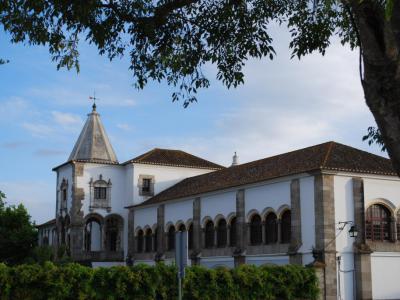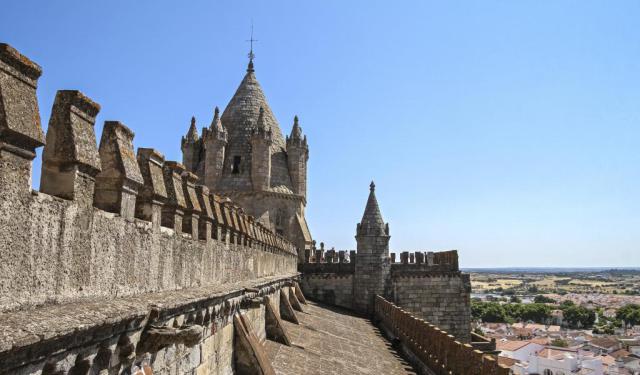
Paco Real de Evora (Royal Palace of Évora), Evora
The Royal Palace of Évora, also known as the Royal Palace of São Francisco and the Palace of King Manuel I, stands as a testament to Portugal's regal history and architectural splendor.
Originally established as a convent in the 13th century, the palace's early days were marked by the tranquil spirituality of its monastic inhabitants. In the 14th century, when the royal family sought refuge in the Alentejo region, the convent opened its doors to accommodate them. However, it was under the reign of King John I that the palace began its journey towards becoming a royal abode of grandeur. The king utilized the palace as a personal retreat, setting the stage for its eventual transformation.
Over the following generations, the Royal Palace of Évora underwent a series of renovations and expansions. It wasn't until the reigns of King John II and Manuel I that the palace truly flourished into a masterpiece of Renaissance architecture, befitting of royalty. Within the palace's walls, history was made. Playwrights like Gil Vicente and explorers like Vasco da Gama graced its chambers, seeking the favor and audience of the king.
After serving as an Archaeological Museum, theater, and exhibition space since 1865, tragedy struck in 1881 when a collapse destroyed its roofs. Adaptations followed, culminating in the transformation of the palace into the Teatro Eborense, a public theater house.
In 1943, a beacon of hope emerged as the National Monuments took on the task of restoration. The essential elements of the original design were salvaged, ensuring that the palace's legacy endured. The subsequent restoration work breathed new life into the palace, preserving its historical significance for generations to come.
Originally established as a convent in the 13th century, the palace's early days were marked by the tranquil spirituality of its monastic inhabitants. In the 14th century, when the royal family sought refuge in the Alentejo region, the convent opened its doors to accommodate them. However, it was under the reign of King John I that the palace began its journey towards becoming a royal abode of grandeur. The king utilized the palace as a personal retreat, setting the stage for its eventual transformation.
Over the following generations, the Royal Palace of Évora underwent a series of renovations and expansions. It wasn't until the reigns of King John II and Manuel I that the palace truly flourished into a masterpiece of Renaissance architecture, befitting of royalty. Within the palace's walls, history was made. Playwrights like Gil Vicente and explorers like Vasco da Gama graced its chambers, seeking the favor and audience of the king.
After serving as an Archaeological Museum, theater, and exhibition space since 1865, tragedy struck in 1881 when a collapse destroyed its roofs. Adaptations followed, culminating in the transformation of the palace into the Teatro Eborense, a public theater house.
In 1943, a beacon of hope emerged as the National Monuments took on the task of restoration. The essential elements of the original design were salvaged, ensuring that the palace's legacy endured. The subsequent restoration work breathed new life into the palace, preserving its historical significance for generations to come.
Want to visit this sight? Check out these Self-Guided Walking Tours in Evora. Alternatively, you can download the mobile app "GPSmyCity: Walks in 1K+ Cities" from Apple App Store or Google Play Store. The app turns your mobile device to a personal tour guide and it works offline, so no data plan is needed when traveling abroad.
Paco Real de Evora (Royal Palace of Évora) on Map
Sight Name: Paco Real de Evora (Royal Palace of Évora)
Sight Location: Evora, Portugal (See walking tours in Evora)
Sight Type: Attraction/Landmark
Guide(s) Containing This Sight:
Sight Location: Evora, Portugal (See walking tours in Evora)
Sight Type: Attraction/Landmark
Guide(s) Containing This Sight:
Walking Tours in Evora, Portugal
Create Your Own Walk in Evora
Creating your own self-guided walk in Evora is easy and fun. Choose the city attractions that you want to see and a walk route map will be created just for you. You can even set your hotel as the start point of the walk.
Evora Introduction Walking Tour
Nestling in the sun-drenched Alentejo region of Portugal, Évora is a timeless gem in the heart of the country and one of its oldest and most enchanting cities.
The city's history spans over 5,000 years. The name Évora originates from the Celtic word "ebura," which means "of the yew trees."
The Romans conquered the place in 57 BC, shaping it into a vital town at... view more
Tour Duration: 2 Hour(s)
Travel Distance: 3.3 Km or 2.1 Miles
The city's history spans over 5,000 years. The name Évora originates from the Celtic word "ebura," which means "of the yew trees."
The Romans conquered the place in 57 BC, shaping it into a vital town at... view more
Tour Duration: 2 Hour(s)
Travel Distance: 3.3 Km or 2.1 Miles

